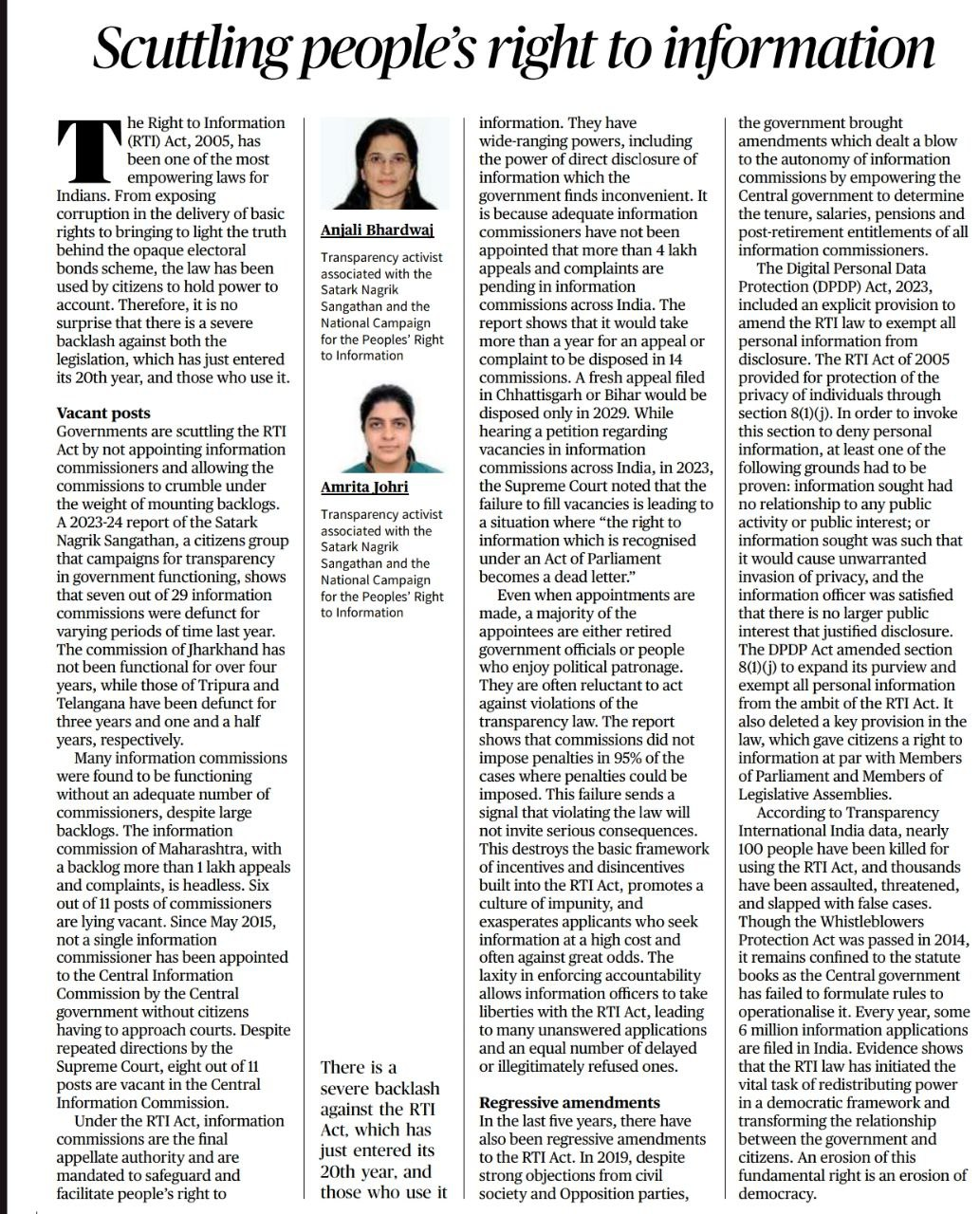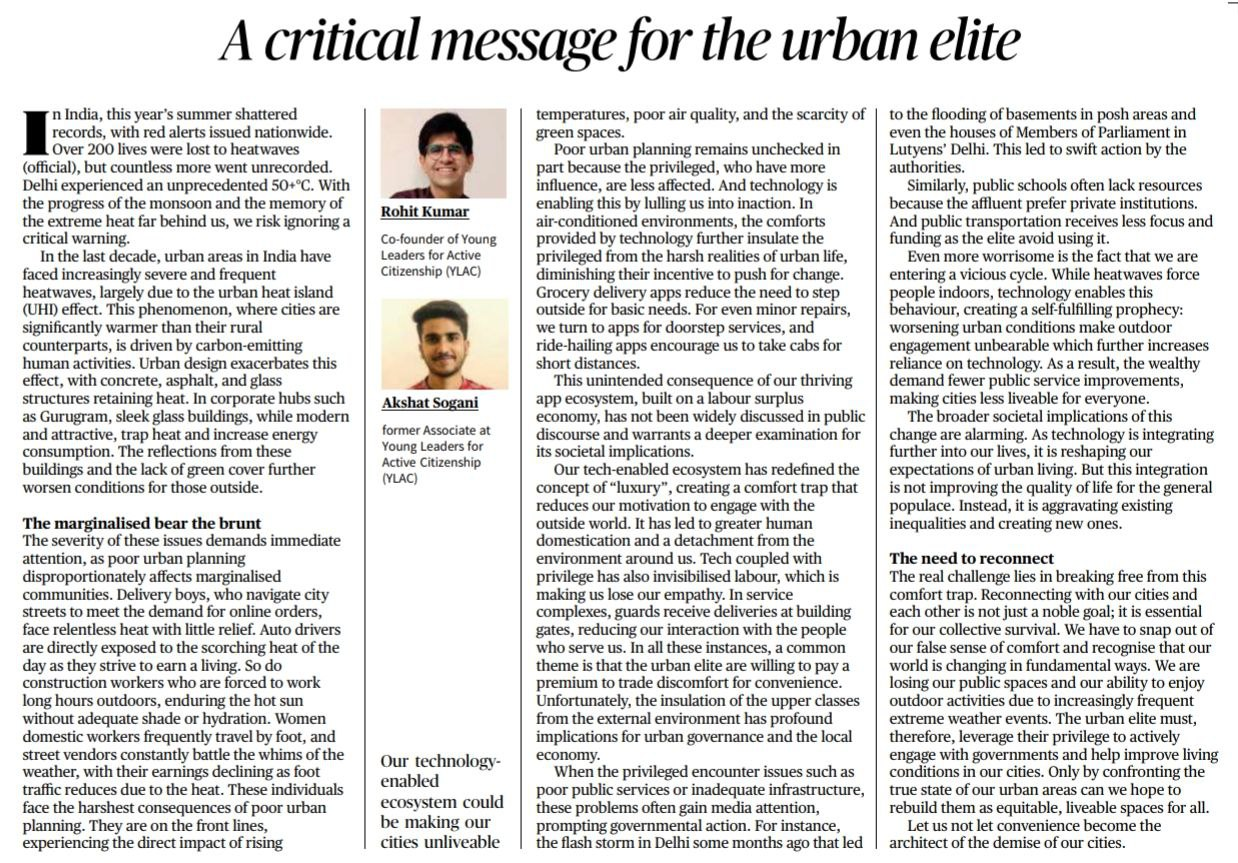1. Undermining the Right to Information: Challenges and the Way Forward
Introduction:
The Right to Information Act (RTI), 2005, is one of India’s most powerful laws empowering citizens to demand transparency in governance. However, recent developments have threatened the effectiveness of the RTI, raising concerns over the government’s commitment to accountability and transparency.
- Empowerment Through RTI:
- The RTI Act has been instrumental in exposing corruption and ensuring accountability in government.
- Citizens have used RTI to uncover key issues, including details of the opaque electoral bonds scheme.
- Challenges Faced by RTI:
- Vacant Posts:
- Several State Information Commissions (ICs) and the Central Information Commission (CIC) have remained non-functional due to vacant posts.
- As per the Satark Nagrik Sangathan (SNS) report (2023-24), seven out of 29 commissions were defunct, and Jharkhand has been non-functional for over four years.
- The delay in appointments has resulted in backlogs of over 4 lakh appeals and complaints.
- Vacant Posts:
- Delays and Backlog:
- Lack of appointments and delay in disposing of appeals cripple the RTI mechanism. In some cases, the waiting time for an appeal exceeds a year, violating the citizens’ right to timely information.
- Jharkhand, Tripura, and Telangana have been non-functional for extended periods, contributing to these delays.
- Non-Imposition of Penalties:
- There has been a reluctance to impose penalties on officials violating the RTI provisions, further weakening its implementation. The SNS report highlights that penalties were imposed in only 5% of cases.
- Impact of Recent Amendments:
- Dilution of the RTI Act:
- The Digital Personal Data Protection (DPDP) Act, 2023, has expanded exemptions from the RTI, allowing personal information to be withheld.
- Section 8(1)(j) of the RTI Act, initially meant for privacy protection, has been expanded to exempt almost all personal data.
- Political Patronage:
- Many ICs are headed by political appointees, which may compromise the objectivity required for enforcing transparency.
- The Whistleblowers Protection Act, 2014, although passed, has not been effectively operationalized, limiting protection for those exposing corruption through RTI.
- Dilution of the RTI Act:
- Consequences of the Scuttling:
- The non-implementation of penalties and the delays in information access undermine the transparency framework.
- The public’s access to government data is severely restricted, fostering a culture of impunity for officials.
Conclusion:
The RTI Act has been a transformative tool in fostering transparency and accountability in India. However, the government’s reluctance to fill vacancies, impose penalties, and the dilution of the Act through new legislations such as the DPDP Act, pose significant threats to its effectiveness. Ensuring timely appointments and adherence to the framework of the RTI is essential for safeguarding democracy and empowering citizens.
Mains Practice Question
|
“The Right to Information Act is seen as a key pillar of transparency in Indian governance, but recent developments have weakened its effectiveness.” Critically analyze the challenges and suggest measures to restore the spirit of the RTI Act.
|
2. The Urban Elite's Comfort Trap: A Critical Call to Action for Equitable Cities
Introduction:
India’s urban areas are increasingly facing severe and frequent heatwaves, exacerbated by poor urban planning and the urban heat island (UHI) effect.
While extreme weather poses significant challenges for all, it is the marginalised communities—delivery workers, street vendors, construction laborers—who bear the harshest consequences.
In contrast, the urban elite remain largely insulated from these challenges due to their reliance on technology, furthering the divide and contributing to the worsening living conditions in cities.
- The Urban Heat Island Effect:
- Urban heat islands are a byproduct of human activities and city designs dominated by concrete, asphalt, and glass structures, which trap heat.
- Cities like Delhi and corporate hubs like Gurugram experience intense heat due to poor planning, with sleek glass buildings contributing to heat retention.
- Impact on Marginalised Communities:
- Workers such as delivery personnel, auto drivers, construction workers, and domestic helpers are directly exposed to the heat, making their livelihoods more difficult and unsafe.
- These groups, often overlooked, face increased risks from poor air quality, lack of green spaces, and severe temperature changes.
- The Privilege of Insulation:
- The urban elite, benefiting from air-conditioned environments and technology-driven services, are largely insulated from the harsh realities of city life.
- Services like grocery delivery apps, ride-hailing services, and doorstep repairs have created a “comfort trap,” reducing the need to interact with the external environment or the people who serve them.
- Technology’s Role in Invisibility:
- The technology-enabled ecosystem has contributed to a growing disconnection between the privileged and the labor force that powers their conveniences.
- Interaction with workers has diminished as services are increasingly outsourced, making the challenges faced by these workers invisible to the elite.
- Implications for Urban Governance:
- When the elite are insulated from urban problems, they are less likely to demand improvements in public infrastructure and services, worsening conditions for everyone.
- This detachment has resulted in a cycle where public services like transportation and schooling are neglected, and focus remains on elite concerns.
- A Vicious Cycle of Technology Reliance:
- As extreme weather forces more people indoors, the reliance on technology for convenience grows, reducing engagement with the city’s public spaces.
- This self-fulfilling cycle of disengagement exacerbates urban inequalities, as wealthier classes are less incentivized to demand public improvements.
- Breaking the Comfort Trap:
- The urban elite must reconnect with their cities and communities to break free from this cycle of technological insulation and detachment.
- Active engagement with governments and public spaces is crucial to making cities more equitable and liveable for all, especially the marginalised.
Conclusion:
The growing detachment of the urban elite from the realities of city life, compounded by technological convenience, is contributing to the decline of India’s cities.
To build equitable and sustainable urban spaces, it is crucial that the privileged use their influence to advocate for improved public services and infrastructure.
Only through collective action can we address the deepening divides and create cities that are livable for all.
Mains Practice Question
|
Discuss the impact of the “urban heat island” effect on India’s cities and the role of the urban elite in shaping urban governance and public infrastructure. How can the growing inequality in urban spaces be addressed?
|



